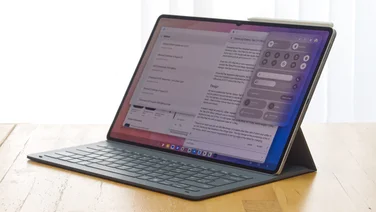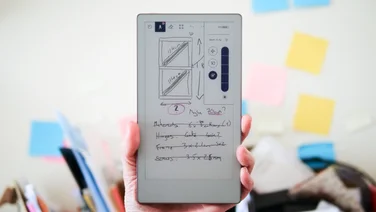To help us provide you with free impartial advice, we may earn a commission if you buy through links on our site. Learn more

Samsung’s superb Galaxy Tab S range has just been replaced by its pair of brand-new Tab S2 tablets, but if you don’t want to pay full price for the Tab S2 9.7 or want something a little larger, then the Galaxy Tab A 10.5 is still a great bargain. With its high-resolution 2,560×1,080 Super AMOLED panel, the Galaxy Tab S 10.5 continues to have one of the best screens around, putting up serious competition to the iPad Air 2, Nexus 9, and even the Sony Xperia Z4 Tablet. It’s also received a £100 price drop since it first launched, too, making it a bit of a big screen bargain.
The Tab S 10.5’s screen uses a slightly different AMOLED technology to Samsung’s smaller Galaxy Tab S 8.4, as the 8.4 has a pentile pixel arrangement, where there are two subpixels per pixel (red and green or blue and green) instead of three (red, green and blue). The Tab S 10.5, on the other hand, has what Samsung calls “S Stripe”, where each pixel has a rectangular red and a green pixel and a longer, thinner “stripe” blue pixel, so each pixel has the full three sub-pixels.

The larger number of sub-pixels on an RGB stripe display can lead to sharper text and more accurate colours compared to pentile. Samsung claims that it had to use the pentile arrangement on the Tab S 8.4 in order to fit so many pixels into the smaller screen, but had no such problems with the larger Tab S 10.5.
Despite the Tab S 8.4’s screen having supposedly inferior technology, we struggled to find fault with it when compared to the Tab S 10.5 in normal use. We noticed that text on the S 8.4’s screen had a slight cross-hatch effect, while the S 10.5’s text consists of pure, solid lines, but you really need to try to spot it.

As a result, both screens look superb and each one was incredibly vibrant. As with its little brother, our calibrator returned a perfect 100% sRGB colour gamut coverage for the Galaxy Tab S 10.5, which compares well to its big rivals, the iPad Air 2 and Xperia Z4 Tablet, as Apple’s top-end tablet scored just 90.7% in the same test, while the Z4 scored 98.3%.
During subjective testing, however, the picture became a bit more muddled. When browsing web pages, we preferred the Z4 Tablet and iPad Air 2’s screens as whites looked cleaner and text more solid. The Tab S 10.5’s screen looked slightly yellow by comparison, but this is a common problem associated with AMOLED displays. The same was true when we switched to viewing photos, as the Tab S 10.5’s screen made our images look oversaturated by comparison.

Samsung does have a secret display weapon up its sleeve, though, as the Tab S 10.5 has an Adaptive Display feature which uses an RGB sensor to automatically adjust the colour range, saturation and sharpness of the screen based on the content you’re viewing at the time. It makes a huge difference when it’s turned on, and the sheer richness of colour and fine shadow detail on show was vastly superior to what we saw on the iPad Air 2.
This is quite an achievement for Samsung, but its victory was a rather muted one once we put the Tab S 10.5 next to Sony’s Xperia Z4 Tablet, as Sony’s display was the clear winner for visual fidelity. Moreover, the Adaptive Display only works with a limited number of apps, such as the Gallery, Samsung’s proprietary Internet browser and video player and Google Play Books, so you won’t get the benefit in every application.
Design
The Xperia Z4 Tablet does cost another £200, though, and for its price, the Tab S 10.5 still has one of the best displays around. That quality is matched by the tablet’s design, too. The tablet is available in standard Samsung white, but our review model came in Titanium Bronze.

This is a remarkably classy-looking mix of sparkling bronze around the screen, a gold surround around the chassis and a dimpled soft-touch rear. The Tab S feels well made, with no flex in the chassis. At 6.5mm, it’s not as slender as the iPad Air 2 or Xperia Z4 Tablet, but there’s not much in it when you hold each of them in your hand. Likewise, the Galaxy Tab S 10.5 is a fraction heavier at 465g, but this isn’t surprising given its larger screen.
As with Samsung’s other mobile products, the Tab S 10.5 is made from plastic rather than metal. We don’t have a problem with this, though, as plastic, when it’s done well, can still feel well made. In this case, Samsung’s certainly done a good job and the Tab S 10.5 looks and feels like a premium product.
On the rear of the case are two indentations, which look a little strange. These are the mounting points for the cases, which click firmly into position rather than using magnets. It takes a little bit of force to get a case on, but once in place the mounting points certainly feel secure. Samsung has both a screen cover and a book cover available for the Tab S 1.05, with the latter completely encompassing the tablet for protection. The book cover also has three standing modes, all at different angles: viewing videos and photos, for using the touchscreen and for typing. The book case is our favourite, as it looks classy and gives you flexibility.

The tablet’s Home button doubles as a fingerprint scanner, which you can use to unlock the device, to log in to your Samsung account or to pay for items with PayPal. You can register up to three fingers, and we had no problems registering our fingers or thumbs. It quickly became our favourite way to unlock the tablet.
Performance & Battery Life
The Galaxy Tab S uses Samsung’s eight-core Exynos 5 Octa system-on-a-chip, which consists of four ARM Cortex-A15 cores running at 1.9GHz and four Cortex-A7 chips running at 1.3GHz. The trick is that the less powerful, and therefore more energy-efficient, cores can take over for less intensive tasks, helping to prolong the tablet’s battery life. It certainly seems to do the trick, as the Tab S 10.5 lasted an excellent 13h 27m in our continuous video playback test with the screen brightness set to our standard 170cd/m2 brightness. This surpasses both the iPad Air 2 and the Nexus 9, so even the most power-hungry users should be able to get a full day’s use out of the Tab S 10.5 without having to return to the mains.
Admittedly, the tablet only completed our BaseMark OS II test with a measly score of 816, which is slower than the budget Tesco Hudl2 managed. However, Samsung’s TouchWiz interface showed no signs of lag when opening and closing applications, and its various animations, such as minimising applications to go back into the main app tray, were smooth and largely judder-free.

The same can’t be said of the Galaxy Tab S 10.5’s web browsing performance, though, as it tended to stutter when scrolling through complex pages containing large numbers of images. This is disappointing for such a high-end tablet and our below average score of 1,356 in BrowserMark certainly seemed to back up this impression.
The tablet has reasonable graphics performance. Its score of 17,234 in BaseMark X 1.1 on Medium graphics settings shows it should have enough power to run most games in the Google Play Store. However, 3D games may still pose a bit of a problem, as shown by a mediocre frame rates of 17.1fps in the BaseMark Dunes test and 22.1fps in the Hangar test.
Conclusion
We’re amazed that Samsung has managed to squeeze such a huge-resolution AMOLED screen onto a £300 tablet. The screen, helped by the clever Active Display technology, is just beautiful, and provides a worthy rival to the iPad Air 2‘s display. The tablet’s performance isn’t always what it should be, and we wish Samsung would put this screen on a tablet with a high-end Snapdragon chip, but it certainly makes it an attractive prospect for those looking for an Android alternative to the iPad Air 2. However, for those after the very best 10in Android tablet, it doesn’t get any better than the Sony Xperia Z4 Tablet.






